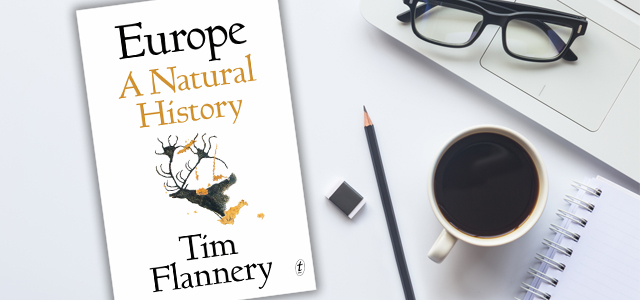Review: Europe: A Natural History
Author: Tim Flannery
Our home-grown historian and writer on the environment Tim Flannery is known for his writings in the Australian setting, but he can equally apply his curiosity to other lands, as is evident by his well-regarded natural history of North America, The Eternal Frontier. Now he turns his attention to Europe, retaining an Australian sense of humour and an Australian eye for the little battlers – tenacious toads and newts – and also for the quirky – giant pterosaurs and pygmy hippos.
We think of Europe as conquered and ordered by humans, but wilderness persists. There are more wolves in Europe than in North America. The continent is rich in natural history, evident by its strong nature writing tradition. More than one enthusiast has exhausted a family fortune obsessively documenting its wonders. Flannery shares this enthusiasm. (One assumes he is more financially prudent though.)
The evident geological richness, from volcanoes to exquisite fossils to the recent (in geological terms) uplifting of the Alps was a catalyst for the revolution in the eighteenth and nineteenth centuries in what we now term the Earth Sciences, and a rethinking of the complexity of the Christian tradition of Creation. Twisted rock strata, shells on mountain tops and layers of salt beneath the Mediterranean initially confused Europeans but pointed to the dynamic nature of what was beneath their feet. This dynamism is, somewhat paradoxically, responsible for the current, deceptively stable and hospitable Europe.
The landmass we now call Europe started as an archipelago, and Flannery argues that islands have always been important in Europe’s story. Periods of isolation created unique animal species. More recently, island hopping in the Mediterranean prepared Europeans for long, exploratory sea voyages. As the land masses rose and connected with Asia and Africa, zoological and botanical exchange flourished. As today, Europe was a site of migration and cross-pollination. The fluctuations of geology and climate allowed for waves of conquering species but also subsequent extinctions.
Since the decline of the dinosaurs, as Europe cooled, species not normally thought of as European – orangutans and palms, for example – took refuge in Asia, and Flannery suggests that if we want to see what Europe was like 20 million years ago, we should visit Malaysia. European animals spread even to Australia and were only killed off with the arrival of the first humans from South East Asia.
The retreat of glaciers at the end of the last Ice Age created fertile soils and ideal conditions for the flourishing of humans. While for most of the time since, humans have lived symbiotically with the rest of Nature, as in the very English phenomenon of hedgerows, industrial agriculture is threatening the diversity that makes Europe so biologically rich. Europeans are talking of ‘rewilding’ but as in other parts of the world, this is controversial. Flannery himself has an enthusiasm for the reintroduction of wild elephants!
Nick Mattiske blogs on books at coburgreviewofbooks.wordpress.com












